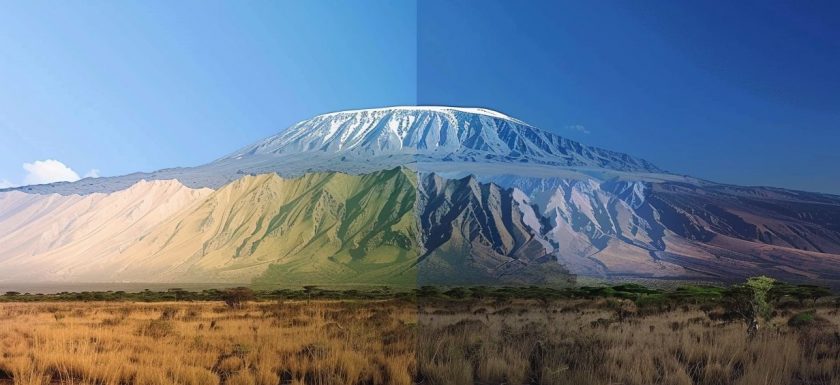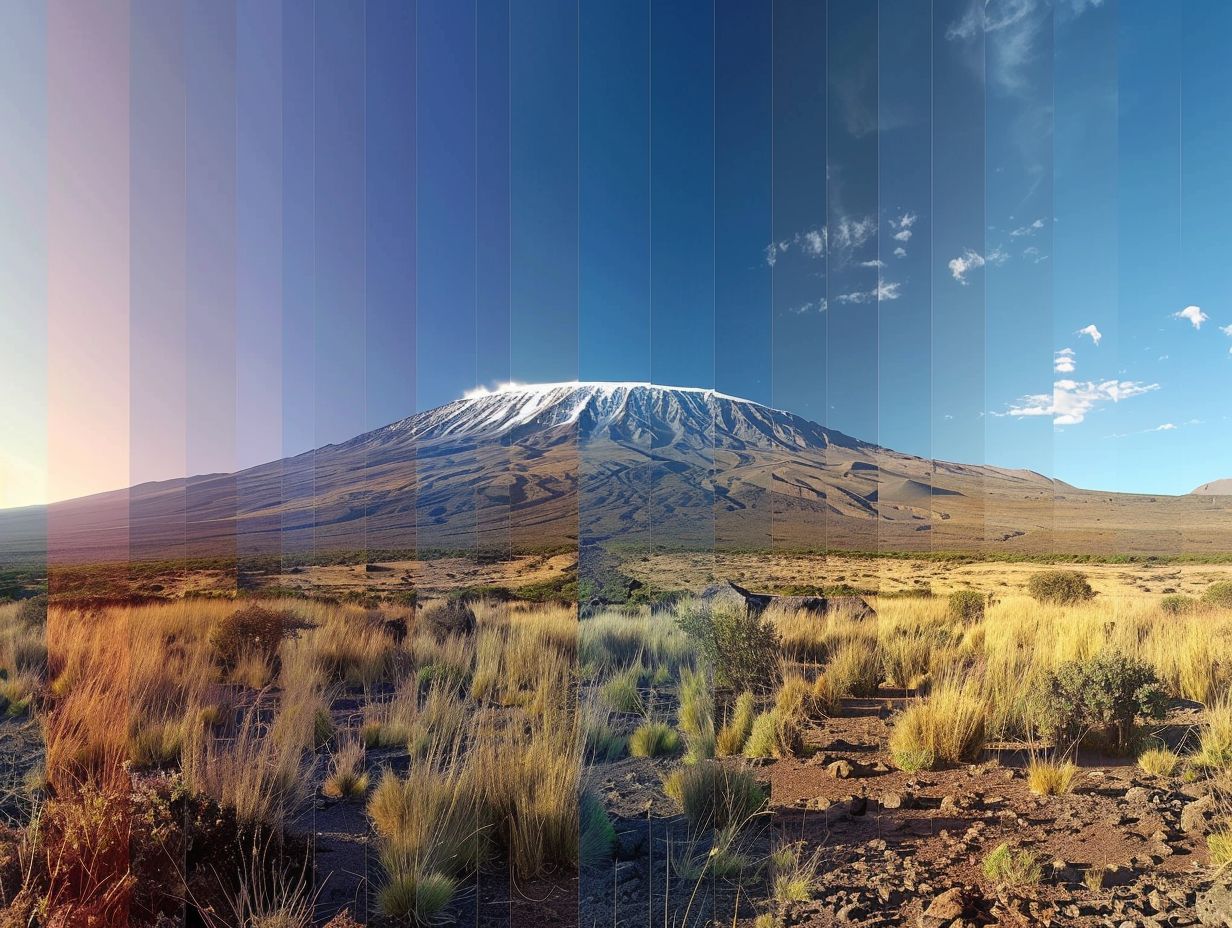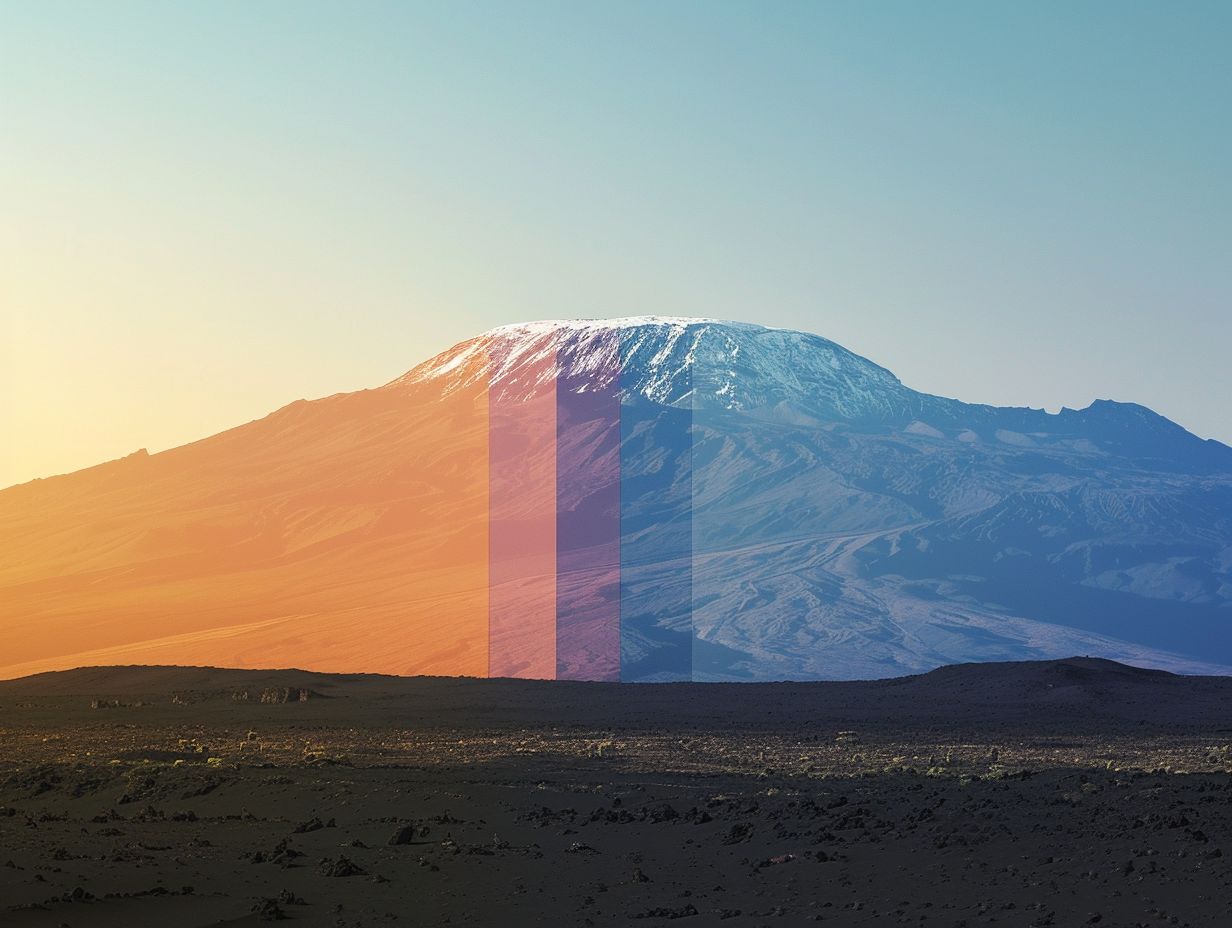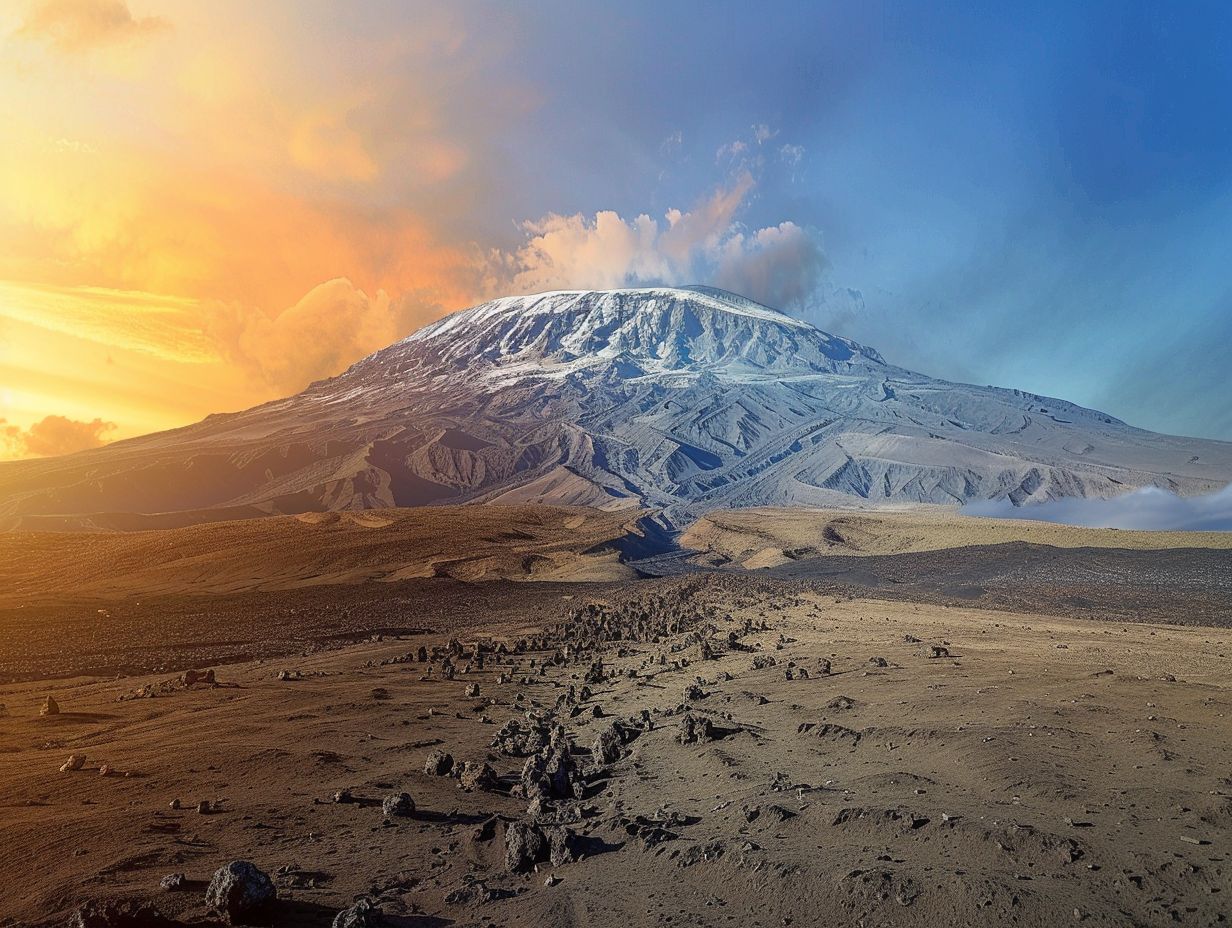
Have you ever wondered what the climate is like on Mount Kilimanjaro?
From the lush rainforest to the icy Arctic zone, Kilimanjaro boasts five distinct climate zones that each offer a unique experience for climbers.
We explore the factors that influence the climate on Kilimanjaro, the characteristics of each climate zone, and how these zones can impact your climb.
Understanding the climate on Kilimanjaro is essential for a successful summit, whether you are preparing for different weather conditions or choosing the right route.
Key Takeaways:

- The climate on Mount Kilimanjaro is influenced by various factors such as altitude, topography, and proximity to the equator.
- Kilimanjaro has five distinct climate zones, including the Cultivation Zone, Rainforest Zone, Heath and Moorland Zone, Alpine Desert Zone, and Arctic Zone.
- Each climate zone on Kilimanjaro has unique characteristics in terms of temperature, precipitation, vegetation, and wildlife, and climbers must prepare accordingly.
What is the Climate Like on Mount Kilimanjaro?
The climate on Mount Kilimanjaro varies significantly due to its diverse altitude range, resulting in distinct climate zones that support various ecosystems and wildlife.
At the base of the mountain, you’ll find a warm and humid climate with lush rainforests. As you ascend, the temperature drops due to the altitude increase, leading to a cooler and more arid environment in the montane forest belt. Moving further up, the heath and moorland zone prevails, characterized by lower temperatures and moss-covered landscapes.
The highest reaches of Kilimanjaro are often snow-capped, creating an alpine climate with freezing temperatures and icy conditions. This extreme contrast in temperatures and precipitation levels shapes the diverse flora and fauna found at each altitude, from towering trees at the base to resilient mosses and lichens near the summit.
What Factors Influence the Climate on Kilimanjaro?
The climate on Kilimanjaro is primarily influenced by its altitude, resulting in distinct vegetation zones from tropical rainforests to arctic conditions near the summit. The temperature and precipitation levels change drastically as one ascends the mountain, impacting the ecosystems and plant life.
As one begins their journey up Kilimanjaro, they first encounter the lush tropical rainforests in the lower altitudes, characterized by abundant vegetation and vibrant wildlife.
However, as elevation increases, the temperatures drop significantly, transitioning into montane forests with diverse plant species adapted to cooler conditions.
Continuing further upward, the transition to the heath and moorland zones takes place around 2500 meters, marked by shrubby plants and unique high-altitude flora. The alpine desert zone follows above 4000 meters, where the harsh conditions limit vegetation to hardy mosses and lichens.
The Five Climate Zones of Kilimanjaro
Mount Kilimanjaro boasts five distinct climate zones, each characterized by its unique vegetation, temperature ranges, and precipitation levels, showcasing the diversity of ecosystems as one climbs in altitude.
Starting from the lowest zone, the Cultivation Zone is dominated by lush farmlands and settlements.
Moving further up, the Rainforest Zone is abundant with dense vegetation, including mosses, ferns, and towering trees.
The Heath Zone then transitions to shorter plants like heather and grasses, displaying a noticeable drop in temperature.
The Moorland Zone introduces a stark landscape with sparse vegetation and colder conditions, leading to the final Alpine Desert Zone, where only hardy succulents and grasses can survive amidst freezing temperatures and low precipitation.
Cultivation Zone
The cultivation zone on Kilimanjaro is located at the mountain’s base, where the fertile volcanic soil supports agriculture and sustains the livelihood of local communities such as the Chagga people.
The Chagga people, skilled in the art of cultivating the land, have created terraced fields that cascade down the slopes of Kilimanjaro, maximizing arable land use.
Maize, bananas, coffee, and various vegetables thrive in this region, benefiting from the temperate climate and abundant rainfall. These crops not only provide sustenance for the locals but also contribute to the local economy through trade and commerce.
Rainforest Zone

The rainforest zone on Kilimanjaro is characterized by lush vegetation, abundant wildlife, and high precipitation levels, creating a vibrant ecosystem that is home to diverse species of flora and fauna.
In this unique ecosystem, the dense canopy of trees provides a habitat for a variety of plant species, from towering trees to delicate ferns and colorful orchids.
The constant supply of moisture due to the high precipitation levels sustains a rich undergrowth of shrubs and mosses, fostering a thriving environment for insects, birds, and mammals.
The rainforest zone is a haven for wildlife, with species such as elephants, buffaloes, leopards, and monkeys roaming amidst the lush foliage. The canopy acts as a perfect shelter for smaller creatures like tree frogs, chameleons, and a myriad of bird species.
Heath and Moorland Zone
The heath and moorland zone on Kilimanjaro is characterized by grasslands, low shrubs, and unique plant species adapted to the alpine climate, offering a transition between lower and higher altitude ecosystems.
This transitional zone plays a vital role in the ecosystem dynamics of Kilimanjaro, acting as a buffer between the lush rainforests below and the stark alpine desert above.
The heath and moorland zone experiences cooler temperatures and higher winds than the lower altitudes, creating a challenging environment for plant life to thrive in. Dwarf shrubs, tussock grasses, and scattered heather are common sights in this zone, displaying remarkable adaptability to the harsh conditions.
Alpine Desert Zone
The alpine desert zone on Kilimanjaro is characterized by barren landscapes, sparse vegetation, and harsh temperatures, resembling arctic conditions as climbers approach the summit.
At these high altitudes, the lack of oxygen adds to the challenge, testing the physical endurance of climbers. The environment’s stark beauty is captivating yet unforgiving, with rocky terrain and icy winds whipping across the slopes.
In this otherworldly landscape, one can’t help but marvel at the resilience of life that manages to survive in such harsh conditions. The interplay of light and shadow creates a surreal panorama where every step closer to the summit feels like a triumph over nature herself.
Arctic Zone
The arctic zone on Kilimanjaro encompasses the summit region, where temperatures plummet, and climbers experience icy conditions, as observed by NASA Earth Observatory during expeditions to monitor the mountain.
At this high altitude, the landscape transforms into a winter wonderland, with snow and glaciers creating a breathtaking yet challenging environment for those venturing to the top. NASA Earth Observatory has utilized advanced technologies such as satellites and remote sensing to track the glacier dynamics and changes in snow cover over time on Kilimanjaro.
What Are the Characteristics of Each Climate Zone?
Each climate zone on Kilimanjaro exhibits unique characteristics in terms of temperature ranges, precipitation levels, vegetation types, wildlife diversity, and ecosystem adaptations, creating a remarkable display of natural diversity.
Starting from the lowermost zone, the cultivated zone experiences a temperate climate with mild temperatures and occasional rainfall. Moving upwards, the rainforest zone is marked by high precipitation, lush vegetation including tree ferns and giant heather, and various bird species like sunbirds and turacos.
Transitioning into the moorland zone, temperatures drop, giving rise to open landscapes with tussock grasses and lobelias. The alpine desert zone, the most challenging, is characterized by rocky terrain, low precipitation, and unique flora like the endemic Kilimanjaro plant. The summit zone is a frozen wonderland, where only the hardiest plants and animals, like the elusive Kilimanjaro mouse, can survive.
Temperature and Precipitation

The temperature and precipitation levels on Kilimanjaro vary significantly across the different climate zones, influencing the ecosystems and biodiversity present at various altitudes.
For instance, the lower slopes of Kilimanjaro are characterized by a warm and humid climate, experiencing high levels of rainfall throughout the year.
As one ascends to the montane forest zone, temperatures cool down, and mist often shrouds the landscape. This unique environment fosters a biodiverse ecosystem with lush vegetation, including giant heather and ferns.
However, as climbers make their way up to the alpine desert zone, they will encounter significantly colder temperatures and drier conditions.
The sparse vegetation in this region, dominated by hardy grasses and lichens, reflects the harsh climate. At the summit, where glaciers persist, the extreme cold and low precipitation levels create an environment unlike any other on the mountain.
Vegetation and Wildlife
The vegetation and wildlife on Kilimanjaro vary across the different climate zones, showcasing a rich diversity of ecosystems that support a wide range of plant and animal species.
Adaptation is key when it comes to survival in these varying conditions.
In the lower slopes, lush rainforests thrive with species like colobus monkeys and elephants, adapted to the humid environment.
As elevation increases, the landscape transitions to heath and moorland, where unique plants like giant groundsels and lobelias have evolved to cope with colder temperatures and thinner air.
At the alpine desert zone, only the hardiest species like the endemic Kilimanjaro tree groundsels can endure the harsh conditions, showcasing the remarkable resilience of life in the face of adversity.
How Do These Climate Zones Affect Climbing Kilimanjaro?
The diverse climate zones on Kilimanjaro present unique challenges and opportunities for climbers, influencing weather conditions, risks of altitude sickness, route selection, and ultimately, the success of reaching the summit.
Given Kilimanjaro’s varying climates, climbers often experience extreme temperature changes as they ascend. The glacial conditions of the summit contrast with the lush rainforest at the base, demanding appropriate gear and preparation.
Weather fluctuations play a crucial role in determining safe climbing windows, affecting visibility and safety. Altitude acclimatization becomes paramount, with gradual ascents designed to combat potentially fatal altitude sickness. Careful consideration of route selection is key, with each path offering unique challenges based on terrain and overall difficulty.
Preparing for Different Weather Conditions
Climbers on Kilimanjaro must prepare for a wide range of weather conditions, varying from tropical heat in the lower zones to freezing temperatures at the summit, necessitating appropriate gear and clothing for safety and comfort.
At the foothills of the mountain, temperatures can soar as high as 30 degrees Celsius, reflecting the equatorial climate of the region. As the ascent progresses, the mercury drops drastically, reaching sub-zero levels at the peak. The climatic transitions are quite abrupt, demanding resilience and adaptability from trekkers.
Rainfall is common, especially during the wet seasons, adding an extra challenge for those making the journey. Therefore, thorough preparation, including layering options, insulated jackets, and waterproof gear, is crucial for a successful climb.
Acclimatization Strategies
Effective acclimatization is crucial for climbers on Kilimanjaro to prevent altitude sickness and adapt to the changing conditions as they ascend through the ecological zones, requiring gradual altitude gain and sufficient rest periods.
One of the key acclimatization strategies recommended for climbers is the ‘climb high, sleep low’ approach, where climbers ascend to a higher altitude during the day but descend to sleep at a lower elevation. This technique allows the body to slowly adjust to higher altitudes while still giving it the chance to recover at lower levels.
Staying hydrated is vital at high altitude as dehydration can exacerbate altitude sickness. Climbers are advised to drink plenty of water and avoid alcohol and caffeine, both of which can contribute to dehydration.
Gradual altitude gain is essential to acclimatize effectively. Climbers should pace themselves, allowing their bodies to adapt to the decreasing oxygen levels in the air. This gradual ascent helps prevent altitude sickness and improves overall climbing performance.
Choosing the Right Route

Selecting the appropriate route on Kilimanjaro is critical for climbers to optimize their chances of summit success, with options like the Machame Route or Marangu Route offering varying experiences and success rates within the Mount Kilimanjaro National Park.
Each route on Kilimanjaro presents its own unique challenges and attractions. The Machame Route, known for its stunning scenery with diverse landscapes, is popular among experienced trekkers seeking a more adventurous climb.
Contrastingly, the Marangu Route, often referred to as the ‘Coca-Cola Route’, is favored for its gradual inclines and hut accommodations, making it a good choice for beginners. The significance of proper acclimatization cannot be understated when embarking on this high-altitude adventure, as it greatly impacts climbers’ overall safety and success rates.
Frequently Asked Questions
What are the different climate zones found on Mount Kilimanjaro?
There are five main climate zones found on Mount Kilimanjaro: the cultivated zone, the rainforest zone, the heather-moorland zone, the alpine desert zone, and the arctic zone.
What is the temperature range in the cultivated zone of Kilimanjaro?
The temperature in the cultivated zone of Kilimanjaro ranges from 68°F to 86°F (20°C to 30°C) during the day and can drop to around 50°F (10°C) at night.
What type of vegetation can be found in the rainforest zone of Kilimanjaro?
The rainforest zone of Kilimanjaro is lush and green, with a variety of trees and plants such as fig trees, giant heather, and ferns.
Is it possible to experience snow in the alpine desert zone of Kilimanjaro?
Yes, it is possible to experience snow in the alpine desert zone of Kilimanjaro. This zone is known for its cold and dry conditions, making it the perfect environment for snow to accumulate.
How does the altitude affect the climate on Mount Kilimanjaro?
As you climb higher on Mount Kilimanjaro, the temperature and oxygen levels decrease, creating a colder and more inhospitable environment. This is why it is important to acclimatize properly when attempting to summit the mountain.
What is the driest and coldest climate zone found on Mount Kilimanjaro?
The arctic zone, also known as the summit zone, is the driest and coldest climate zone found on Mount Kilimanjaro. This zone is characterized by freezing temperatures and strong winds, making it a challenging environment for climbers.